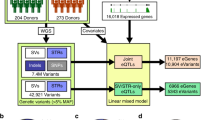Abstract
VNTR (variable number of tandem repeat) markers, also called single-copy minisatellites, were originally isolated from human DNA as highly informative restriction fragment length polymorphisms for mapping purposes. Evidence has lately emerged that some VNTR sequences play significant roles in the regulation of transcription, and that some may also influence the translational efficiency or stability of mRNA, or modify the activity of proteins by altering their structure. Some apparent associations of VNTR sequences with personality traits or with susceptibility to diseases have strengthened the likelihood that these tandemly-repeated genomic elements are of physiological and biological importance. In this review, we summarize recent progress in efforts to clarify mechanisms involving VNTR sequences.
Similar content being viewed by others
Article PDF
Author information
Authors and Affiliations
Additional information
Received: April 11, 1998 / Accepted: May 2, 1998
Rights and permissions
About this article
Cite this article
Nakamura, Y., Koyama, K. & Matsushima, M. VNTR (variable number of tandem repeat) sequences as transcriptional, translational, or functional regulators. J Hum Genet 43, 149–152 (1998). https://doi.org/10.1007/s100380050059
Published:
Issue Date:
DOI: https://doi.org/10.1007/s100380050059
This article is cited by
-
Investigating the relationship between the VNTR variant of the interleukin-1 receptor antagonist gene and coronary in-stent restenosis
Molecular Biology Reports (2023)
-
A multicenter case–control study of the effect of e-nos VNTR polymorphism on upper gastrointestinal hemorrhage in NSAID users
Scientific Reports (2021)
-
Short rare minisatellite variant of BORIS-MS2 is related to bladder cancer susceptibility
Genes & Genomics (2019)
-
The association of insertions/deletions (INDELs) and variable number tandem repeats (VNTRs) with obesity and its related traits and complications
Journal of Physiological Anthropology (2017)
-
A polymorphic minisatellite region of BORIS regulates gene expression and its rare variants correlate with lung cancer susceptibility
Experimental & Molecular Medicine (2016)



